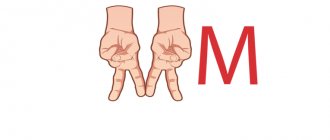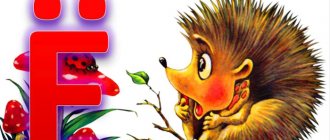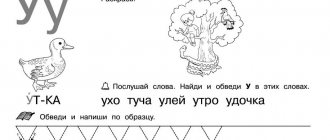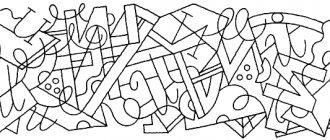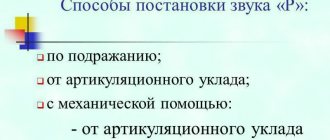GCD for teaching literacy in kindergarten. Senior group
This material is intended for kindergarten teachers.
The GCD summary will be useful in working with children of the senior/preparatory group, the educational area of cognition (learning to read and write). Outline of educational activities for teaching literacy for the senior group of kindergartens (it is more expedient to carry out in subgroups)
Topic.
Introducing children to the word. Goal: to form children’s ideas about the word as an intonation and semantic unit of speech. Program objectives: 1. Familiarize the child with the word. 2. Acquiring the ability to listen attentively to the spoken word. 3. Learn to ask and distinguish the questions “Who is this?”, “What is this?” 4. Fix in children’s speech a word denoting a “living” or “non-living” object. 5. Continue to educate children to speak every word distinctly, clearly, intelligibly. Materials and equipment: player for audio recordings;
a beautifully designed box with riddle pictures in it; doll; teddy bear; photograph of a bear; a set of pictures “Fun exercise”, depicting a human figure in motion; the summary uses the didactic game “Add a word” by the author I. Tokmakova; warm-up by E. and S. Zheleznov “We are stomping, stomping, stomping.” GCD move:
Part I.
- Guys, there are many different objects around us, and we can say something about each object. Now I will show you pictures and ask “What is this?”, and you answer me in one word (pointing to various inanimate objects). Children answer, for example, book, table, ball, etc. - How can you ask about these items? What is this? - And now I’ll ask you differently: “Who is this?” (I show pictures, point to animate objects: a bird, a fish, a cat, I point with my hand at the nanny, at the children, at myself). How can you ask? Who is this? - Now I will name you different objects, and you ask me the question “who?”, “what?” (Thus, I gradually introduce children to the concepts of “living” and “non-living”). — I invite a girl at will, put a doll next to her and ask the children a question. — What is the difference between a girl and a doll? (children name the differences and together come to the conclusion that the girl is alive, and the doll is inanimate, a toy). Then I show an illustration with a bear and a toy bear depicted on it. - Guys, are they any different from each other? We find out that the bear toy is not alive, but the picture depicts a living bear. To summarize: - All words denoting inanimate objects answer the question “what?”, and words denoting living objects answer the question “who?”
Part II.
Physical pause “Fun exercise”, the cards show schematic images of little people in different poses.
Children need to repeat the same movements. Part III.
- Guys, look at what an unusual box I have, it’s not simple and very mysterious, because there are a lot of mysteries for you that are waiting, can’t wait to be helped, finally solved. - Interesting? Then listen carefully to the end of each riddle and answer the questions “who is this?”, “what is this?”. Is this object living or inanimate? •What always goes, but never leaves its place? (hours) •Winter and summer the same color? (spruce) •Do I wake everyone up on time, even though I don’t wind the clock? (cockerel) •Do the red paws pinch the paws? (goose) •She lives in water, has no beak, but does she peck? (fish) •Without a tongue, but speaks, without ears, but will he hear? (phone) Next, I invite the children to come up with or remember a riddle on their own and ask all the children. Children make riddles and guess. This object is called living or inanimate.
Part IV.
Physical pause “We stomp stomp stomp with our feet”, children perform exercises to the music: We stomp stomp stomp with our feet, We clap clap clap with our hands, And we can turn here and there without difficulty.
We will nod our heads, wave our arms together, and turn here and there without difficulty. We will jump high, Jump together so easily, And we will turn here and there without difficulty. Part V
- Now, I will say the word, and you tell me what it means, how you understand it. Listen, book! What does this word mean? (Children's answers). - That's right, you understand well what the word book means, what meaning it has. - Now, I will pronounce different sound combinations. Listen: na, mu, rum, po, ba, etc. Tell me, is it clear what they mean, what meaning they have? (Children's answers). “These are not words, these are just sound combinations, syllables that by themselves, separately from each other, mean nothing, have no meaning.” And when the syllables together they make up words, and each word has a meaning, a meaning. - Let's play the game “Add a word.” A spoon is a spoon, soup is eaten with a spoon...(eat) A cat is a cat, a cat has seven...(kittens). A rag is a rag, I’ll wipe it with a rag... (table). A hat is a hat, I got dressed and went... And I came up with a word, a funny word - plim. And I repeat again - plim, plim, plim. Doesn't jump, doesn't jump plim, plim, plim, And plim, plim, plim doesn't mean anything. — What is “plym”? That's right, this word doesn't mean anything. (Children are asked to say the word “plim” with different intonations). -Now, let's play the game “Name the Word” (goal: learn to distinguish between words denoting an object and words denoting actions). In front of the children, I lay out object pictures on the table depicting a table, a butterfly, a cube, a sitting person, a running child, etc. -Children, look at the pictures and name one word to which you can ask questions: who is this? What is this? What is he doing? (for each correct answer the child receives a picture).
Part VI.
Final. - Thank you, I liked the way we played today. Today we learned so many new things (here you can ask several children what new they learned). Summarize. - Today we learned that all words denoting inanimate objects answer the question “what?”, and living objects answer the question “who?”, we also know that words consist of syllables, and each word has a meaning.
We recommend watching:
Summary of GCD for introducing older preschoolers to the work of the poet Fet Summary of plot-based GCD in physical education for children of the senior group Summary of GCD in the senior group of compensatory orientation GCD in kindergarten for older preschoolers
Similar articles:
Proverbs about the word
Summary of GCD in the senior group on the topic “Communication”
Summary of GCD in the senior group of kindergarten on the topic “Relaxation”
Summary of a lesson on cognition in the senior group on the topic “Dairy products”
Summary of a lesson on cognition in the senior group on the topic “Construction professions”
Summary of educational activities for preparing for teaching literacy in the senior group on the topic “Sounds [a], [u]. Letters A, U"
author: Gantseva Marina Arkadyevna
Teacher-speech therapist Federal State Budgetary Preschool Educational Institution "Kindergarten No. 568", Yekaterinburg
Summary of educational activities for preparing for teaching literacy in the senior group on the topic “Sounds [a], [u]. Letters A, U"
Summary of educational activities for preparing for teaching literacy in the senior group
on the topic “Sounds [a], [u]. Letters A, U"
The summary was compiled by:
Gantseva M. A. (teacher-speech therapist)
Federal State Budgetary Educational Institution "Kindergarten No. 568", Yekaterinburg
Tasks:
- clarify the concept of “vowel sounds”;
- learn to differentiate the sounds [a], [u];
- learn to highlight the first sound in a word;
- learn to select words with a given initial sound using visual support and without it;
- develop phonemic hearing;
- develop skills in sound analysis and synthesis of syllables, reading syllables (ay, ua);
- fix the graphic image of the letters A, U;
- develop memory;
- cultivate curiosity, interest in sounds and letters;
- cultivate a caring attitude towards things (aids used in class).
Equipment:
- laptop, projector, speakers, presentation; cards for continuous reading of syllables (au, ua); magnetic board, red chips (magnets); letters A, U; pointer; diagram for determining the place of a sound in a word, red chip;
- for children: individual mirrors; diagrams for determining the place of a sound in a word; sound pencil cases (with chips in red, green and blue); notebooks; cards for continuous reading of syllables (au, ua); cash registers; simple pencils, counting sticks (letter set).
GCD move:
- Introductory part. Game "Memorize and repeat"
:
| watermelon – shark – orange pineapple – apricot – Africa album – stork – arch | morning - street - ear Ulya - mind - mustache already - knot - clever |
Articulation gymnastics
. “Window”, “Tube”, “Window - tube”, moving the lips with a “proboscis” to the right and left, “Horse”.
SLIDE No. 2
- Main part:
1) “Sounds [u], [a], we know you!”:
— What sounds did we study? (A, U) Let's remember about them, everything we know.
SLIDE No. 3
- How is Anya crying? (A)
SLIDE No. 4
- How does a wolf howl? (U)
SLIDE No. 5
- Now listen to me and guess who it is: Anya or the wolf? (The speech therapist pronounces the sounds [a], [u] several times, the children guess everything together and individually)
SLIDE No. 6
Clarification of the articulation of sounds [a], [u].
Children tell the snail about the articulation of the sound [u], and Aibolit - about the articulation of the sound [a].
The articulation analysis plan appears gradually in the presentation:
- lips
- teeth
- language
- how the air comes out of the mouth (freely) - a “breeze” flies out (picture)
Guessing sounds from silent articulation.
SLIDE No. 7
- What color are the sounds [a], [u]? In what color castle do the sounds [a], [u] live? (Children choose)
SLIDE No. 8
Characteristics of sounds (vowel sounds). Children tell Dunno.
- What is the sound? (Vowel) Why? (Air comes out of the mouth freely).
- What is the sound? (Vowel) Why? (Air also comes out of the mouth freely).
SLIDE No. 9
2) Game “Name the first sound in the word.”
The speech therapist and children take a diagram to determine the place of a sound in a word, put a red chip in the first window (the sound at the beginning of the word)
Pictures appear on the screen, children name them by highlighting the first sound and clicking on the chip. Children name the first sound (all together and individually).
Pictures: pineapple, stork, duck, bus, iron, fishing rod, shark, oranges, snail, duckling, apricot, street.
3) Didactic game “Guess the word” (based on pictures).
SLIDE No. 10
The speech therapist says: “I will make words. To guess a word, you will need to add the first sound to it - [a] or [y]. Pictures will help you guess the words.” Vocabulary material: ...pelsins, ...tyug, ...bus, ...tenok, ...bricot, ...fabric, ...litka, ...daughter, ...kula, ...faces, ...nanas, ...ist..
4) Physical exercise “A or U?”
The speech therapist pronounces the sounds [a], [u]. Children, if they hear the sound [a], pretend to be a stork; if they hear the sound [u], they pretend to be a Cheburashka with big ears.
SLIDE No. 11
— Guys, let's talk about the letter U.
SLIDE No. 12
5) Letter U.
- Showing a letter.
- Finding a letter in the cash register.
- “How many elements does the letter U have? What are these elements? What does this letter look like?
- Laying out letters from sticks.
- Game “Right - Wrong” (Children determine whether the letter U is written correctly)
SLIDE No. 13
- Drawing a letter in the air (On the screen there is a slide with animation - a snail is crawling, helping to correctly draw the letter U in the air).
SLIDE No. 14
- Game “Identify the sound U”. Children name the pictures that appear on the letter U, emphasizing the sound [u]. Perform finger exercises:
- “Fishing rod” - show the index finger of the right hand (the other fingers are clenched) and rotate the thumb of the left hand.
- “Snail” - first depict a snail with one hand (show the index and middle fingers - “horns”), move the hand along the table (“the snail is crawling”), then with the other hand.
- “Iron” - depict an iron (put one hand palm down on the table, the other hand on top, “iron”).
- “Duck” - show “beaks” with hands.
SLIDE No. 15
6) Game “Decorate the letter U”
. Children take turns naming words with the sound [y] at the beginning of the word. Each child says a word, and flowers appear on the screen (on the letter U).
SLIDE No. 16
— We remembered everything we know about the letter U. Now let's talk about the letter A.
Letter A - first letter a
alphabet (Children notice that the word “alphabet” begins with the sound [a].
7) Letter A.
- Showing a letter.
- Guys, find the letters A on this slide (the speech therapist calls one child to the board, he shows the letters with a pointer: A, a)
- “How many elements does the letter A have? What are these elements?
SLIDE No. 17
- Laying out letters from sticks.
SLIDE No. 18
- Finding a letter in the cash register.
- What does this letter look like?
SLIDE No. 19
- Drawing a letter in the air (On the screen there is a slide with animation - watermelons are moving, helping to correctly draw the letter A in the air).
SLIDE No. 20
 Game “Decorate the letter A”
Game “Decorate the letter A”
. Children take turns naming words with the sound [a] at the beginning of the word. Each child says a word, and flowers appear on the screen (on the letter A).
SLIDE No. 21
9)
Analysis and synthesis of the syllable AU.
The speech therapist shows a picture of Uli (Ulyana).
— Ulya went into the forest. There were a lot of mushrooms in the forest. While picking mushrooms, she went far into the forest and did not notice how she lost her way. Ole became scared. She remembered a short but very necessary word. If you shout, they will hear you and come to your aid. What word is this? (Aw!)
Children slowly pronounce the “word” AU in chorus and in rows.
- Name the first sound in the word Au (A). What is the sound? (vowel). It is indicated by a red chip (Children place the red chip on the table, and the speech therapist on the magnetic board).
- Name the second sound in the word Au (U). What is the sound? (vowel). Label it.
- The first sound is [a]. The second sound is [u]. What happened? (AU) Let’s “read” the word. I lead with a pointer, and you slowly sing each sound in the word (AU).
- Now let’s designate the sounds with letters. Let's read the word (using a card for continuous reading of the syllable AU).
SLIDE No. 22
10) Analysis and synthesis of the syllable UA
.
The speech therapist shows a picture of a crying child.
— The baby cries: “Wow!”
Children slowly pronounce the word UA in chorus and in rows.
The syllable UA is parsed similarly.
SLIDE No. 23
11) Typing syllables
AU, UA.
SLIDE No. 24 with the inscription “Well done!”
- The result of GCD. Reflection.
- Name words with the sound A. Name words with the sound U.
Summary of educational activities for preparing for teaching literacy in the senior group on the topic “Sounds [a], [u]. Letters A, U"
